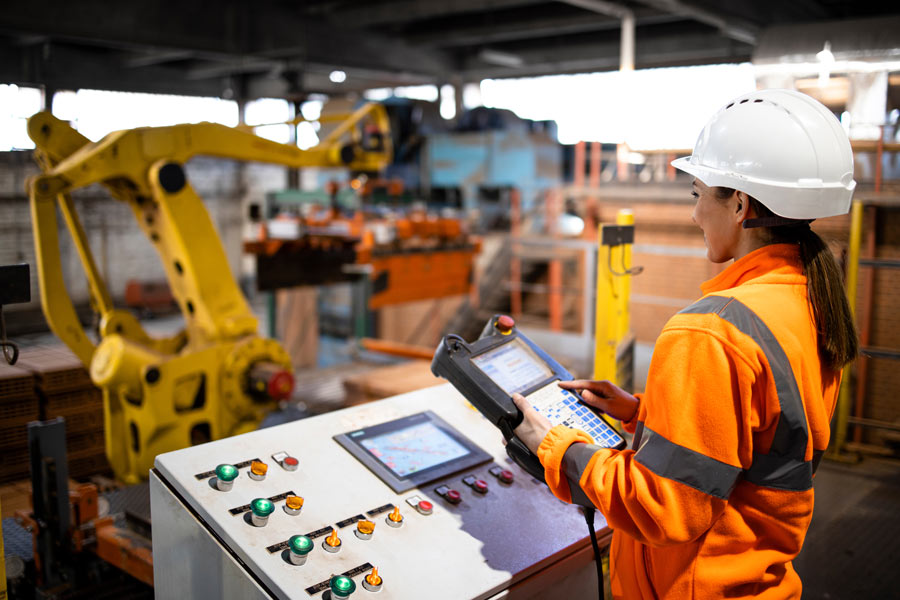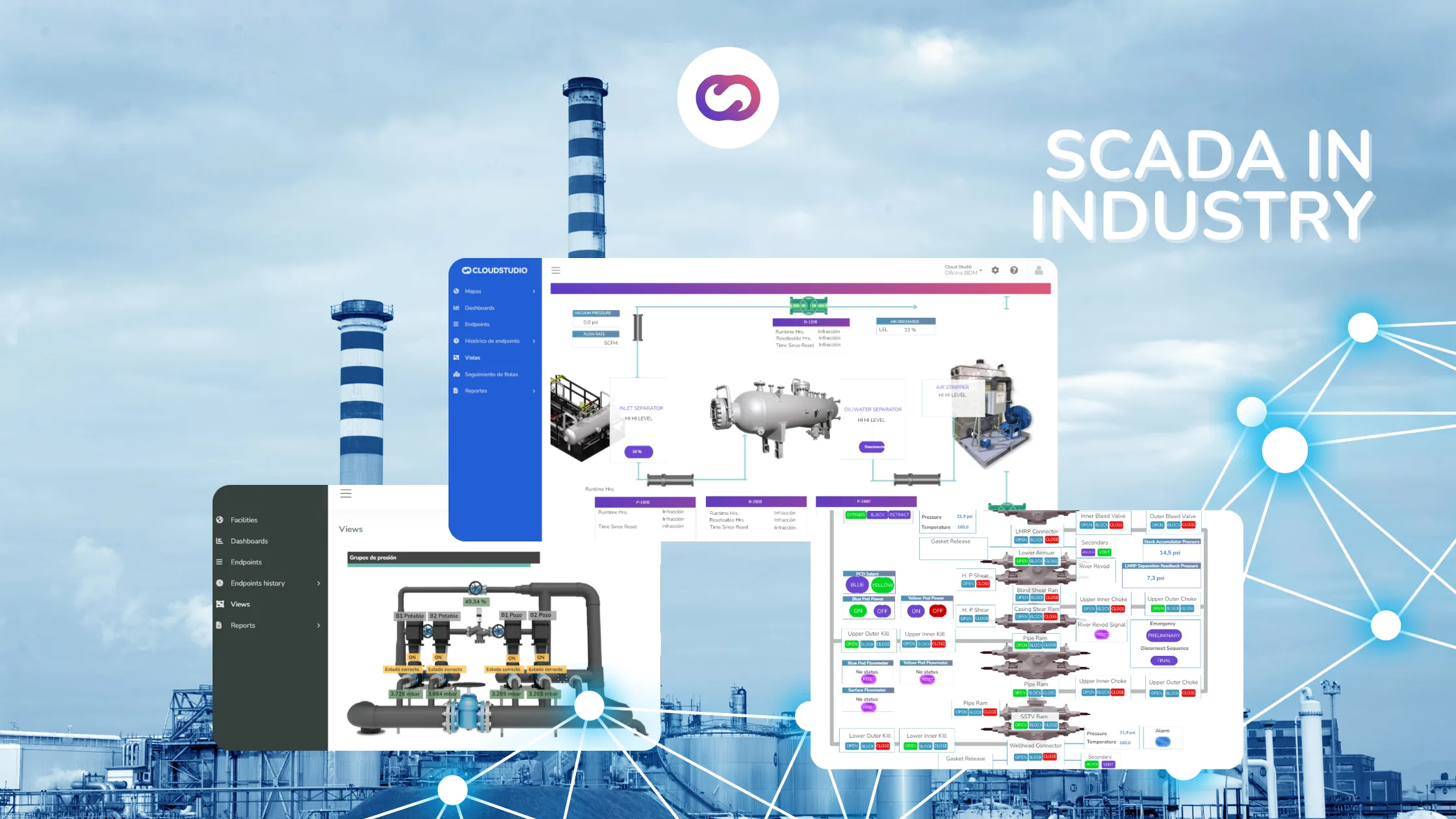SCADA and real-time monitoring
Real-time monitoring and control is one of the essential functions of SCADA systems. With the support of IoT, these systems enable remote supervision of critical processes, collecting real-time data to make informed decisions. This is key to improving operational efficiency and minimizing risks in industrial operations.
For example, in the manufacturing industry, SCADA can detect anomalies in machine performance and trigger automatic alerts to prevent major disruptions. Additionally, when combined with IoT dashboards, operators can access information from any connected device, providing flexibility in management.

Image of a traditional industrial Supervisory Control and Data Acquisition panel
A real-world example is the monitoring of assembly lines, where SCADA systems collect metrics such as production speed, product quality, and machine status, helping to prevent costly errors and maintain high-quality standards.
What is SCADA?
SCADA stands for Supervisory Control and Data Acquisition. It is a system designed to monitor and control industrial infrastructures and processes in real-time. These systems are used in industries such as manufacturing, energy, transportation, water, and telecommunications, allowing operators to visualize live data, record historical information, and automate responses to critical events.
Components of a SCADA system
- Sensors and actuators: Capture environmental data such as temperature, pressure, or fluid levels.
- Controllers (PLC or RTU): Process captured information and execute commands according to control logic.
- Communication network: Transports data between field devices and the central system, using protocols such as Modbus, DNP3, or IEC 60870.
- Human-Machine Interface (HMI): A visual platform that allows operators to supervise and manage the system.
- Database and servers: Store operational data and facilitate analysis and report generation.
Those systems not only enhance efficiency and security in industrial operations but also enable real-time, data-driven decision-making. With the evolution of IoT and cloud computing, SCADA platforms are increasingly integrating with advanced technologies to improve connectivity and automation. If you want to learn more about SCADA and its future, we recommend visiting our article on the subject.
Smart energy management
Energy management is crucial in the pursuit of sustainability and efficiency. With SCADA, industries can monitor energy consumption, identify inefficiencies, and optimize processes. This results in a significant reduction in operational costs and compliance with stricter environmental regulations.
In renewable energy facilities, Industrial SCADA systems integrated with IIoT (Industrial Internet of Things) maximize the efficiency of solar panels or wind turbines by automatically adjusting parameters based on demand and weather conditions. For example, a solar farm can benefit from SCADA by tracking energy production in real-time and making precise adjustments to optimize performance.
Additionally, these systems allow companies to generate detailed reports on their energy consumption, supporting strategic decision-making to reduce their carbon footprint.
Control of transport and logistics systems

Logistics is one of the fields most benefited by the integration of Supervisory Control and Data Acquisition
The ability to track and manage fleets in real-time is another key advantage of them. Integration with IoT facilitates vehicle and cargo tracking, optimizing the supply chain.
A practical example is the use of them to prevent congestion on transport routes, improving delivery times and reducing operational costs. Additionally, in maritime transport, it also can monitor parameters such as engine speed, fuel consumption, and weather conditions, ensuring the safety and efficiency of operations.
Modern logistics also benefit from the ability to integrate multiple data sources, such as temperature sensors in refrigerated vehicles, to ensure the integrity of perishable products during transport.
Advanced predictive maintenance
Predictive maintenance is one of the most advanced applications of the concept. Through IoT sensors, these systems collect operational data and detect patterns indicating potential failures, allowing interventions to be planned before serious problems occur.
This capability not only reduces downtime but also significantly lowers maintenance costs. For example, in the petrochemical industry, a SCADA system can monitor pressure and temperature in critical pipelines, alerting operators to potential risks before they turn into major failures.
Another key advantage is the generation of detailed reports that help identify areas for improvement, optimizing the life cycles of equipment and reducing the need for frequent investments in new assets.
Industrial security management

Industrial security is one of the strongest priorities for IoT in recent years
Security is a priority in any industrial environment, and SCADA systems play an essential role. With the use of IoT, it is possible to monitor operational conditions in real-time and activate alarms when risks are detected.
For example, in a chemical plant, it can detect gas leaks and alert the security team for an immediate response, minimizing risks to workers and infrastructure. In the mining industry, sensors connected to SCADA can track ground conditions to prevent landslides or unexpected explosions.
Additionally, these systems allow security simulations and risk analysis to develop more robust protocols, ensuring a safer working environment.
Traditional or Web SCADA
Over time, SCADA systems have evolved from local platforms to web-based solutions, each with advantages and disadvantages depending on the implementation environment.
Traditional
Traditional is based on local servers and control stations within the company’s infrastructure. It is characterized by:
- Greater security: Operating within a closed network makes it less vulnerable to external attacks.
- Lower Internet dependency: Functions without cloud connection, ensuring operational continuity.
- Infrastructure costs: Requires physical servers and specialized hardware.
- Limited scalability: Expansion can be costly and complicated.
Web SCADA
Web SCADA is a modern evolution based on cloud technologies and accessible via browsers. Its main advantages are:
- Remote access: Allows process supervision and control from any location with an Internet connection.
- Flexible scalability: Can grow without large investments in hardware.
- Lower maintenance: Server management and updates can be delegated to cloud providers.
- Greater connectivity: Facilitates integration with other platforms and IoT devices.
Conclusion
SCADA applications, combined with IoT, are revolutionizing the industry by providing tools for efficient, sustainable, and secure control.








